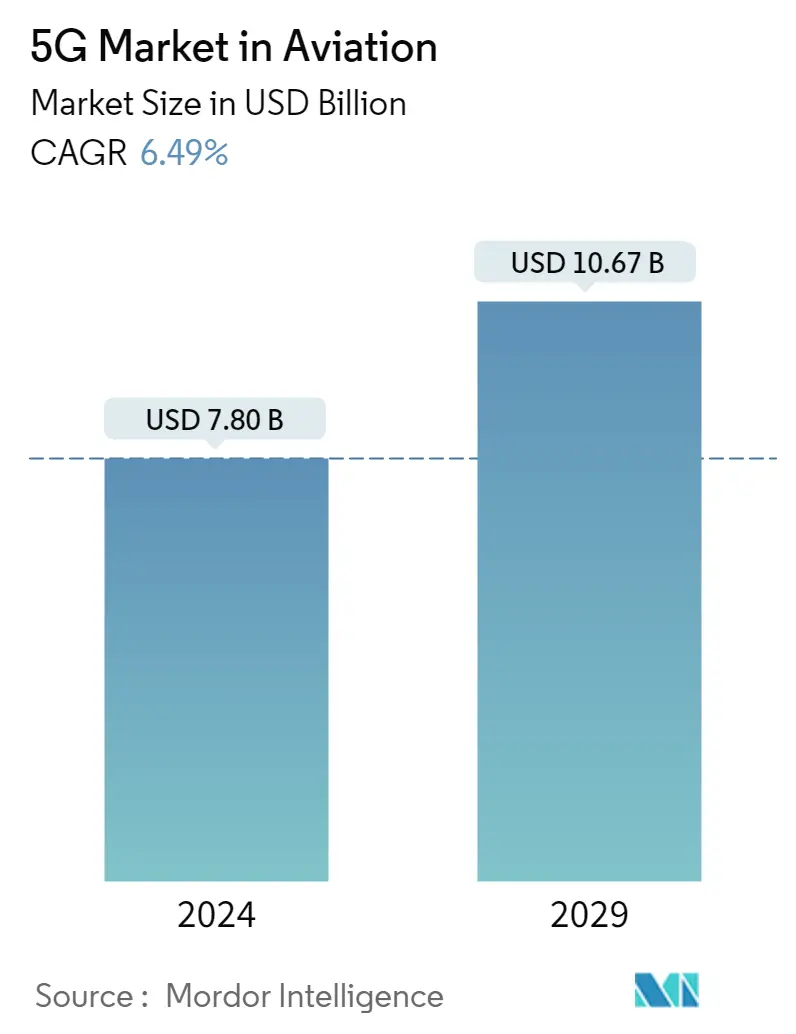Market Size of 5G Industry in Aviation

| Study Period | 2019 - 2029 |
| Market Size (2024) | USD 7.80 Billion |
| Market Size (2029) | USD 10.67 Billion |
| CAGR (2024 - 2029) | 6.49 % |
| Fastest Growing Market | Asia-Pacific |
| Largest Market | North America |
Major Players
*Disclaimer: Major Players sorted in no particular order |
Need a report that reflects how COVID-19 has impacted this market and its growth?
5G in Aviation Market Analysis
The 5G Market in Aviation Industry is expected to grow from USD 7.80 billion in 2024 to USD 10.67 billion by 2029, at a CAGR of 6.49% during the forecast period (2024-2029).
The growing air passenger traffic, increasing application of connected technologies such as IoT in the aviation sector, and growing need for fast internet connectivity and better flight experience service are some of the factors driving the 5G market in aviation.
- 5G technology is one of the most invested technologies by many end-user industries in the global market. In the aviation industry, 5G is witnessing significant owing to a rise in passenger footfall, leading to a substantial rise in demand for more bandwidth and faster speed from passengers. Airline companies and other airport stakeholders are also seeking fast, seamless, and secure connectivity experiences for their essential technologies to enhance the passenger experience.
- The adoption of IoT is increasingly becoming part of the global digitalization trend in the aviation industry. The IoT network in such facilities requires a high-speed communication network, thus significantly boosting the demand for 5G in the aviation sector. For example, Schiphol in the Netherlands has about 70,000 sensors collecting real-time information on the performance of elevators and walkways. Wearables can also be used in an airport to drive efficiency. The Cincinnati/Northern Kentucky International Airport improved facility management using a solution that combines mobile devices, smart sensors, and a cellular network.
- Various industry associations are also further helping adopt the technology in the industry; one of the primary focuses currently is offering a better in-flight connected experience for customers. The Seamless Air Alliance has been formed by OneWeb (a global communications company), Airtel (an Indian Mobile Network Operator), GoGo (a company that works with airlines on in-flight broadband systems), and Sprint (a telecommunications company that delivers wireless services and is an internet service provider (ISP)); whereas the composition of the coalition is completed by Airbus and Delta Airlines.
- 5G connected Artificial Intelligence (AI) is expected to solve major pain points at airports, border checking, and other facilities in the industry. For instance, the technology can help match passengers to their bags as AI will be able to recognize unique scuff marks, creases, and material characteristics to distinguish between seemingly identical bags and match them to the correct passenger.
- Automating the airports and various facilities in such premises is increasingly becoming a reality due to higher communication speeds enabled by the 5G technology. Coupled with various advanced technologies such as AI and IoT, the 5G technology has made significant strides in aviation over the past few years. However, challenges such as 5G service could interfere with airplane altimeters, and safety issues in the aviation sector with 5G implementation may hamper the growth of the market.
- The COVID-19 pandemic resulted in a historical shift in the aviation industry while introducing new airport stakeholders' challenges. Public health measures raised amid the pandemic scenario worsened the bottlenecks in ground operations processes, adding up to the challenges that were already present in the pre-COVID era. However, new technologies, such as the deployment of 5G, offer ways to ease these operational constraints. The powerful features provided by a 5G network can also enable greater efficiency.
